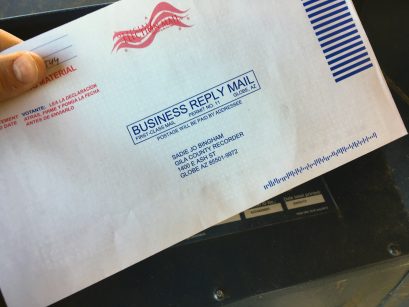Come see a live demonstration at NPF – June 3rd & 4th – Booth 1325

As states and other jurisdictions seek ways to ensure elections are secure and accurate, they are considering vote-by-mail as an alternative to the cost and perceived risk exposure associated with electronic voting machines and in-person polling places. Four states (Oregon, Washington, Colorado, and Hawaii) have legislated all elections be conducted by mail. Twenty-one other states allow vote-by-mail in certain counties or for specific elections.
Vote-by-mail has advantages, but how to handle the incoming ballots in a secure and accurate manner, while swiftly processing large volumes is a challenge jurisdictions must address as they consider making such a move. Chosen equipment must be reliable. Machine breakdowns on election day are problematic. The solution must also provide assurances of accuracy to allow lawmakers to switch to a vote-by-mail election process with confidence.
Voters casting ballots by mail mark their ballots, place them in secrecy envelopes, and then in outside mailing envelopes. Voters sign affidavits on the outside envelope to confirm their identities and affirm they have legally cast their votes. Then they drop their ballots in the mail before the election deadline.
Advantages for Voters, Election Officials, Civic Participation
Interest in vote-by-mail is growing. Voters like not having to rearrange their work days or finding transportation or child care on election day. They can avoid standing in long lines to exercise their voting rights. Different from absentee ballots that often require voters meet certain criteria to qualify, vote-by-mail elections are open to all registered voters.
Election officials are looking for cost savings. Many states anticipate capital expenses to replace voting machines that lack auditable paper trails. Switching to mail-in ballots, which furnish their own paper trail, may be less expensive than investing in electronic voting machines that will eventually be obsolete. Savings opportunities exist. Colorado trimmed an average of 40% from election administration costs after switching to vote-by-mail.
Elections held by mail also affect citizen participation. Some evidence suggests the convenience of vote-by-mail improves voter turnout. In the 2018 mid-term elections, voter turnout in full vote-by-mail states was 10% higher than the national average.
Vote-by-mail also seems to boost down-ballot engagement. Local politicians benefit from voters who would otherwise only complete their ballots for national and state-wide races. Some researchers suggest vote-by-mail encourages voters to be more informed. Citizens have time to research issues and candidates after ballots arrive in the mail and before they send them back to be counted.
Go With a Proven Solution
Jurisdictions contemplating a vote-by-mail solution must address how they will verify and count large volumes of paper ballots when they arrive at election headquarters. Election officials must be sure their solutions include signature validation, duplicate detection, and other quality control and fraud prevention features.
Tritek offers custom-designed processing systems for any volume of ballots and any required applications. The systems support seamless integration with all US states’ database software vendors and features processing speeds up to 15,000 per hour for any size or shaped ballots. Additionally, Tritek’s Correct Elect inbound ballot processing equipment can include mobile machines and the ability to fit into any facility’s space. Tritek equipment is fully configurable. Additional features and sort bins can be added at any time.
Many states and counties are considering vote-by-mail as an alternative to replacing electronic voting machines. Hacking and intrusion attempts, particularly when their voting machines do not include reliable auditing or paper trails, concern government election officials. With Tritek Correct Elect, jurisdictions can switch to vote-by-mail with confidence they have selected a trustworthy field-tested solution.
Come see a live demonstration at NPF – June 3rd & 4th – Booth 1325